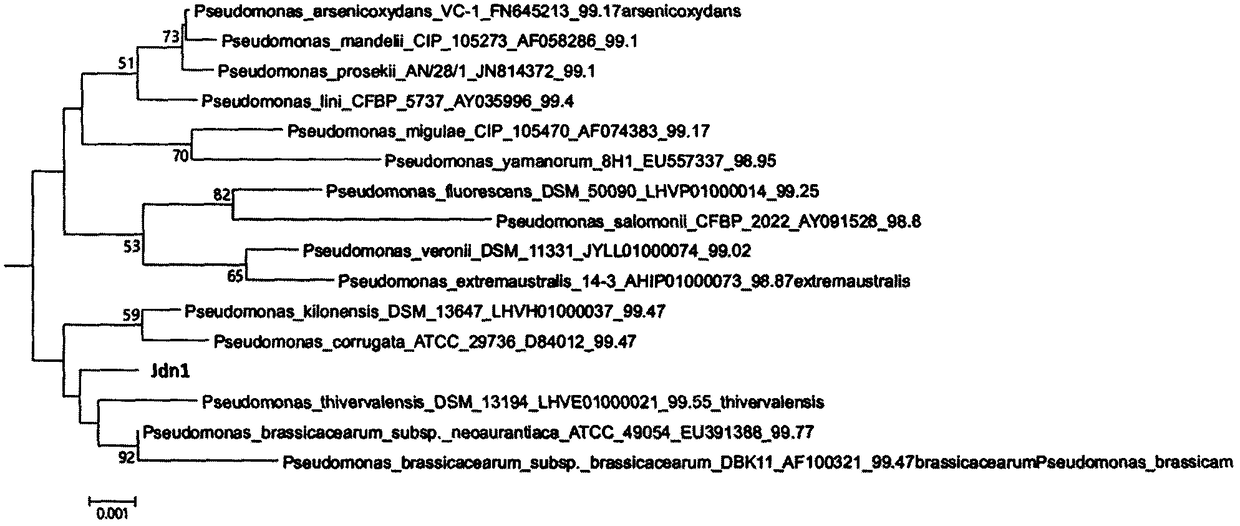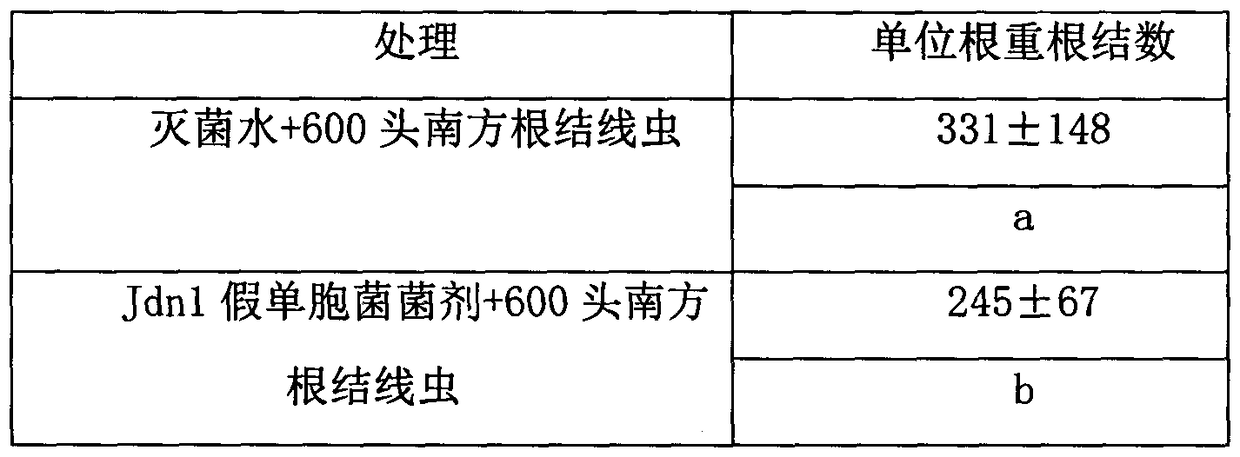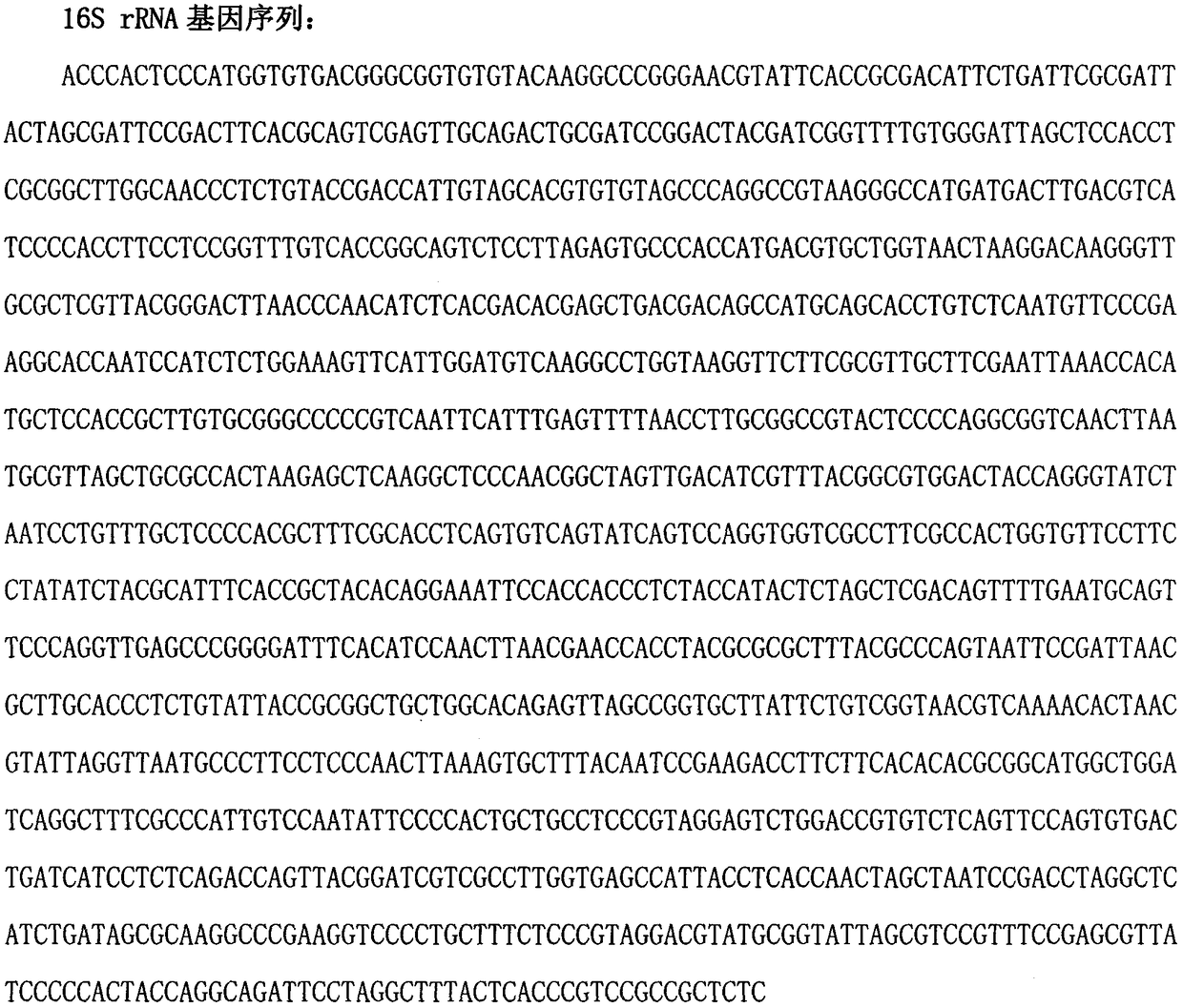Root knot nematode disease prevention pseudomonas strain Jdn1 and microbial agent thereof
A technology of root-knot nematode disease and pseudomonas, applied in the field of microorganisms, can solve the problems of lack of root-knot nematode resistance, etc., and achieve the effects of saving costs, reducing the number of root-knots, and reducing the number of root-knots
- Summary
- Abstract
- Description
- Claims
- Application Information
AI Technical Summary
Problems solved by technology
Method used
Image
Examples
Embodiment 1
[0026] Physiological and biochemical tests of strains and identification of 16S rRNA molecules
[0027] Such as figure 1 As shown, the Pseudomonas strain Jdn1 was activated and cultured on the NA plate at a temperature of 28°C, NA medium: 3g of beef extract (Beef Extract), 10g of peptone (Peptone), 5g of sodium chloride (NaCl), Agar powder (Agar) 15g, pH7.0.
[0028] After culturing for 20-24 hours, it was observed that the single colony of Jdn1 was light yellow, nearly round, transparent, with neat edges and smooth surface. Gram staining of strain Jdn1 is red, which is Gram-negative bacteria. In the aerobic test, the strain Jdn1 grew along the surface of the culture medium, which indicated that the strain Jdn1 was an aerobic bacterium. Physiological and biochemical tests are oxidase, catalase, propionic acid, acetic acid, formic acid, L-lactic acid, L-malic acid, citric acid, α-ketoglutarate, α-D-glucose, D-mannose, sucrose, glycerol All were positive; gelatin liquefactio...
Embodiment 2
[0033] The preparation method steps of root-knot nematode second instar larvae are as follows:
[0034] (1) Cut the tomato root into pieces and put it into a bottle, add an appropriate amount of 20% sodium hypochlorite solution for immersion, and shake vigorously for 3 minutes.
[0035] (2) Pour the tomato roots into the standard sieves (30 mesh, 100 mesh, 300 mesh, 500 mesh) listed in descending order of sieve density, and wash the eggs onto the 500-mesh standard sieve and collect them.
[0036] (3) The collected eggs are sterilized with 10% sodium hypochlorite solution and washed with sterilized water.
[0037] (4) Put the sterilized nematode eggs into a sterilized device to hatch, and start to collect the hatched nematodes for later use.
[0038] The Pseudomonas bacterial strain of preventing and treating root-knot nematode disease of the present invention, this bacterial strain is Pseudomonas (Pseudomonassp.); Preservation name is Pseudomonas Jdn1; Preserved in China Micr...
Embodiment 3
[0050] Determination of potted control effect
[0051] Irrigate OD to the roots of 3-week-old tomato seedlings 600 For 1 Pseudomonas inoculum, each strain was filled with 10ml. Seedlings poured with an equal volume of sterilized water at the root were used as controls. One week later, 600 nematodes were inoculated on the roots of tomato seedlings. 8 seedlings per treatment, repeated 3 times. After 2 weeks of culture at 25°C, 16h: 8h (light: dark), count the number of root knots and calculate the control effect.
[0052] Control effect (%)=[(control group root-knot number-treatment group root-knot number) / control group root-knot number]×100%
[0053] Table 1 is the determination of potted control effect of Pseudomonas Jdn1 bacterial agent on root-knot nematode disease;
[0054] Table 1
[0055]
[0056] As shown in Table 1, it can be concluded that after 2 weeks of inoculation with 600 root-knot nematodes, the pot experiment results showed that the number of root-knots...
PUM
 Login to View More
Login to View More Abstract
Description
Claims
Application Information
 Login to View More
Login to View More - R&D
- Intellectual Property
- Life Sciences
- Materials
- Tech Scout
- Unparalleled Data Quality
- Higher Quality Content
- 60% Fewer Hallucinations
Browse by: Latest US Patents, China's latest patents, Technical Efficacy Thesaurus, Application Domain, Technology Topic, Popular Technical Reports.
© 2025 PatSnap. All rights reserved.Legal|Privacy policy|Modern Slavery Act Transparency Statement|Sitemap|About US| Contact US: help@patsnap.com



